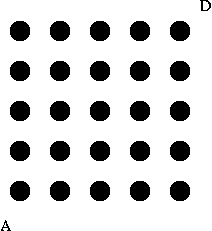
/**
* @param exponent >= 0
* @returns base raised to exponent power
**/
public int simpleRecPower(int base, int exponent)
{
if (exponent == 0)
return 1;
else
return base * simpleRecPower(base,exponent-1);
}
How does this work? Clearly, if we evaluate simpleRecPower(3,0), the condition exponent==0 is true, so the method should return 1. Suppose instead we evaluate simpleRecPower(3,1). According to the method definition and the fact that 1!=0, we get that simpleRecPower(3,1) = 3*simpleRecPower(3,0), and we know the value of simpleRecPower(3,0) is 1. Thus the final answer is 3*1 or 3. The key is that we are using the facts that b0 = 1 and be+1 = b*be to calculate powers. Because we are calculating complex powers using simpler powers we eventually get to our base case.
A handy way of thinking about recursive programs is to think about having someone else handle the recursive call. So if I want to calculate simpleRecPower(3,5), I ask someone else to calculate simpleRecPower(3,4) and then, when they give me the answer, 81, multiply that answer by 3 to get the final answer of 243.
Of course we could also write this method with a while loop:
/**
* @param exponent >= 0
* @returns base raised to exponent power
**/
public int simpleWhilePower(int base, int exponent)
{
int answer = 1;
int counter = 1;
while (counter <= exponent)
{
answer = answer * base;
counter++;
}
return answer;
}
If this is just as easily written using a while, why do we care about recursion? In some cases it provides us with a solution that is more elegant. That elegance can sometimes give us insights that help us to solve a problem more efficiently.
/**
@param exponent >= 0
@returns base raised to exponent power
**/
public int fastPower(int base, int exponent) {
if (exponent == 0)
return 1
else if (exponent%2 == 1) // exponent is odd
return base * fastPower(base, exponent-1)
else // exponent is even
return fastPower(base * base, exponent / 2)
}
In both of the programs given earlier, the number of multiplications necessary is equal to the value of the exponent. That is not the case here.
fastPower(3,16) = fastPower(9,8) // mult
= fastPower(81,4) // mult
= fastPower(6561,2) // mult
= fastPower(43046721,1) // mult
= 43046721 * fastPower(43046721,0)
= 43046721 * 1 // mult
= 43046721
Thus it only took 5 multiplications (and 4 divisions by 2) using fastPower, whereas it would have taken 16 multiplications the other way (and divisions by two can be done very efficiently in binary).
In general it takes somewhere between log2(exponent) and 2 * log2(exponent) multiplications to compute a power this way. While this doesn't make a difference for small values of exponent, it does make a difference when exponent is large. For example, computing fastPower(3,1024) would only take 11 multiplications, while computing it the other way would take 1024 multiplications.
Why does this algorithm work? It works because it is based on the following simple rules of exponents:
The key is that by rearranging the order of doing things in a clever way, we can cut down the amount of work considerably! (Again it is possible to write the above algorithm with a while loop, but the above formulation is arguably easier to understand!)

This problem (and path-finding problems in general) can be solved quite easily using recursion. We notice that from point A, the starting point, we must either pass through the point to our right or we must pass through the point above us (since we can't move diagonally). If we knew the number of paths from our right neighbor and the number of paths from our neighbor above, then all we have to do is add those together!
In general:
public int allPaths(int xStart, int yStart, int xEnd, int yEnd)
{
// the number of paths from our neighbor to the right
int xPaths = 0;
// the number of paths from our neighbor above
int yPaths = 0;
// if the start point is the same as the end point, there's
// only one path.
if (xStart == xEnd && yStart == yEnd)
return 1;
// find out how many paths there are from the neighbor to the
// right of the start point
if (xStart < xEnd)
xPaths = allPaths(xStart+1, yStart, xEnd, yEnd);
// find out how many paths there are from the neighbor above
if (yStart > yEnd)
yPaths = allPaths(xStart, yStart-1, xEnd, yEnd);
// add up the paths from each neighbor and return
return xPaths + yPaths;
}
Try out this Demo, which solves the
problem above. It begins with a display of the 5x5 grid. When you
click the mouse, it will tell you the number of paths found. In
this version, the starting point is the dot in the fourth row and
second column. The end point is the upper right corner. The demo
highlights the grid positions searched. You'll see that it always
searches up and to the right.